#corvus moneduloides
Photo
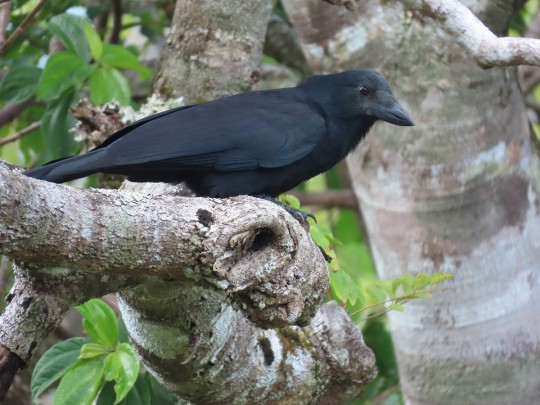
New Caledonian Crow (Corvus moneduloides)
© Jörg Hanoldt
700 notes
·
View notes
Photo
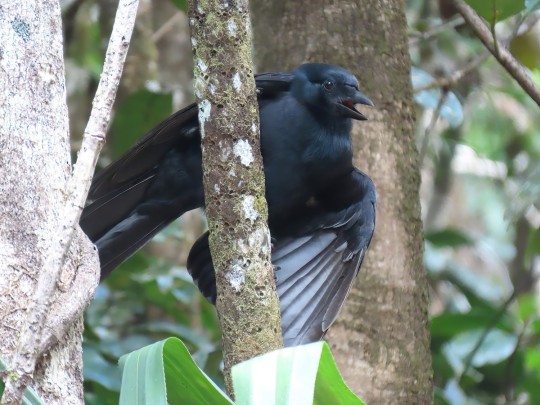
New Caledonian Crow (Corvus moneduloides)
© Jörg Hanoldt
140 notes
·
View notes
Photo
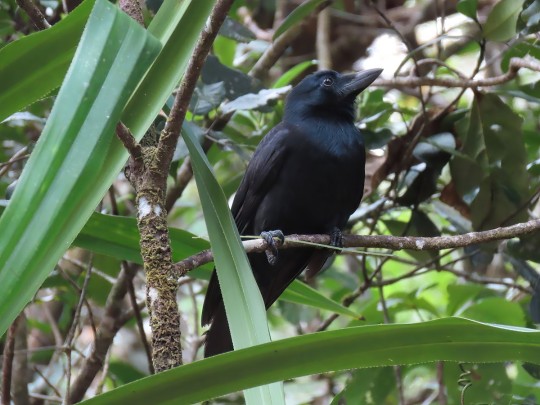
New Caledonian Crow (Corvus moneduloides)
© J��rg Hanoldt
83 notes
·
View notes
Photo

New Caledonian Crow (Corvus moneduloides)
© Jörg Hanoldt
74 notes
·
View notes
Text
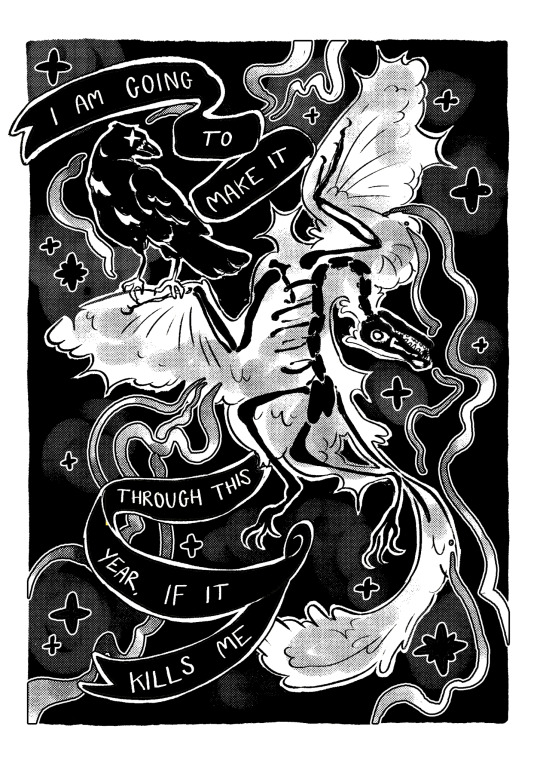
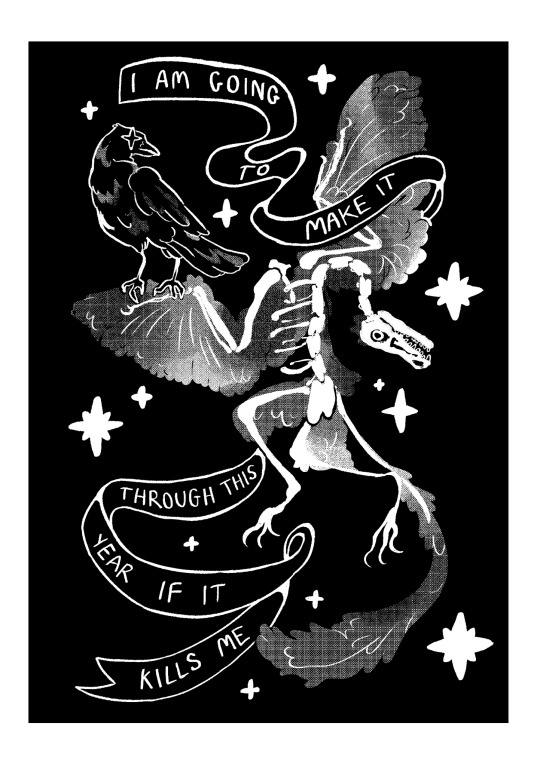
THIS YEAR (2023/2022), two versions of a design for risoprinting. featuring velociraptor mongoliensis & corvus moneduloides
#risoprint#risograph#riso#the mountain goats#tmg#velociraptor#dinosaur#crow#illustration#ellis’s art
207 notes
·
View notes
Text
Corvid Tournament: Corvus Bracket Round 1.1: New Caledonian Crow vs Torresian Crow

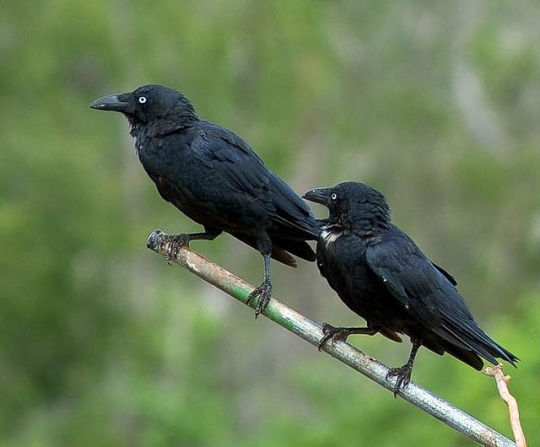
New Caledonian crow (corvus moneduloides): Sometimes called a “qua-qua” due to its distinctive sound, this bird is an all-black crow with feathers that sometimes shine green in certain lighting. It is roughly 40cm/16in long, and has a distinct beak as the tip of its lower beak angles up. It resides only on the islands of Grande Terre and Maré Island in New Caledonia. This crow is truly omnivorous and has been heavily documented on its tool use. They have even been observed to use meta- and compound tools, but they do not pass the mirror test. Its conservation status is “least concern."
Torresian crow (corvus orru): Also called the Australian or Papuan crow, it has one of the widest ranges of the Australian species, inhabiting the North and West regions of Australia, Papa New Guinea, and some Indonesian islands. It is a larger bird at roughly 48-53cm/19-21in long, and has a somewhat robust beak. It has black plumage, but its beak and legs are dark-grey, and it has pink foot soles. Torresian crows are true omnivores, and their conservation status is “least concern."
4 notes
·
View notes
Text
Week 9 - Crows
PROMPT: Interpret (through this blog) the most amazing thing you know about nature – get us excited. This is your blog – you audience isn’t out in the field with you so bring the field to your armchair reader.
Hello again everyone! With only a few blog posts left for this semester, let’s make sure that they are good ones!
For this blog, I will be talking about one of my favorite things to learn about - Birds! Specifically, I would like to talk about a very special interest of mine, corvid intelligence.
Corvids are from the family Corvidae which include crows, jays, magpies, rooks, ravens, and more. They are incredibly special birds because they have a high amount of intelligence equivalent to a great ape, which is incredibly impressive for such a small bird.
I first became entranced about specifically corvids when I was in middle school, reading Mind of the Raven in math class instead of paying attention. It was a really interesting book about different experiments that were done on corvids and explained in depth about their neurology and what part of their brains contributed to what behavior. It was incredibly interesting, although a really tough read for me when I was so young! I remember the back of the book had a whole diagram of the brain that I’d try to sear into my mind as hard as I could. I think this book was my big spark into my love for corvids as well, which is now something I am so passionate about and love to share with others! I currently have two american crows (Corvus brachyrhynchos) tattooed on my body as well.
In 1972, Stanford University created a study called the “Stanford Marshmallow Experiment” which studied delayed gratification and future planning in children. In this experiment, they had children sit in a room with a marshmallow and were told that if they didn’t eat it in 15 minutes, they would get a bigger reward of two marshmallows. What’s interesting about this is that they also tried this experiment with new caledonian crows (Corvus moneduloides), where they had a rotating tray with a small treat and a large treat in a glass case with a hole. The crows were able to immediately get the smaller treat, but had to wait to get the larger one. The larger treat would either be better quality or quantity. They tried this with the rewards hidden and the rewards being visible, and the study showed that the crows did better than the children when the rewards were shown. They were able to judge that they should take the better reward if there was one, while children did not have the ability to judge it as well when they could see both.
It’s really incredible to see these creatures working, and I would one day love to help in this sector of academia as well! There are many other experiments done with crows in particular, such as learning that they can recognize faces, learning that they understand mirrors and their own reflections, they are able to understand physics such as water displacement, and that they can even work specially-designed vending machines, which shows they are able to solve complex puzzles!
Overall, corvids are super incredible and smart birds that I believe everyone should look into the research done on them - they can do such cool things and I would personally love to know just how much they may know! We are slowly learning more about birds such as studies done on Japanese Tits (Parus minor) showed that the order of calls can be similar to language and mean different things!
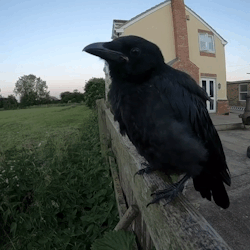
0 notes
Text
3D-printed tweezers based on crow beaks are more dexterous
3D-printed tweezers based on crow beaks are more dexterous
By Emily Bates
Researchers have modelled a pair of tweezers to mimic the shape of the 4.3 centimetre average beak of the New Caledonian crow (Corvus moneduloides) – an intelligent species of bird known to use simple tools. This design was then 3D-printed, with a flexible part connecting the two halves.
Tags:

View On WordPress
0 notes
Photo



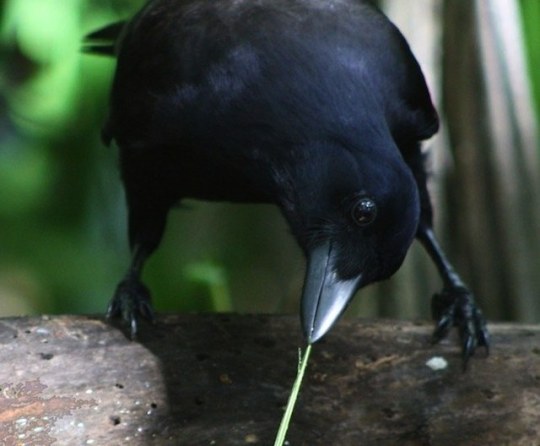

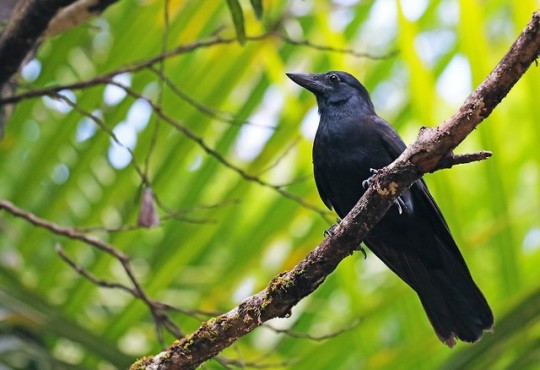




The New Caledonian crow (Corvus moneduloides) is an all-black, medium-sized member of the family Corvidae, native to New Caledonia. The bird is often referred to as the 'qua-qua' due to its distinctive call. The New Caledonian crow sometimes captures grubs in nooks or crevices by poking a twig at the grub to agitate it into biting the twig, which the crow then withdraws with the grub still attached. This method of feeding indicates the New Caledonian crow is capable of tool use. They are able to make hooks. This species is also capable of solving a number of sophisticated cognitive tests which suggest that it is particularly intelligent. As a result of these findings, the New Caledonian crow has become a model species for scientists trying to understand the impact of tool use and manufacture on the evolution of intelligence.
The New Caledonian crow is a moderate-sized crow, (15.7 inches in length) similar in size to the house crow but less slender-looking. The bird has an all-black appearance with a rich gloss to its feathers of purple, dark blue and some green in good light. The beak, feet and legs are all black. The vocalization is described as a soft "waa-waa" or "wak-wak", and sometimes as a hoarse "qua-qua" or "waaaark". Across New Caledonia, the bird is often referred to as a 'qua-qua' due to its distinctive call.
The beak is moderate in size but is unusual in that the tip of the lower mandible is angled upwards, making it somewhat chisel-like in profile. It has been suggested that this beak morphology evolved due to the selective pressure of needing to hold a tool straight.
This bird is endemic to the islands of New Caledonia in the Pacific, living in primary forest. It inhabits only the main island, Grande Terre, and one of the Loyalty Islands, Maré Island.
The New Caledonian crow eats a wide range of food, including many types of insects and other invertebrates (some caught in flight with great agility, including night-flying insects which it catches at dusk), eggs and nestlings, small mammals, snails (which it drops from a height onto hard stones), and various nuts and seeds.
This species uses stick tools in the wild by finding small twigs and probing them into holes in logs to extract insects and larvae. New Caledonian crows are also able to manufacture tools by breaking twigs off bushes and trimming them to produce functional stick tools. Tool manufacture is rare in comparison to simple tool use and indicates a higher level of cognitive function. The crows can also make leaf tools by tearing rectangular strips off the edges of Pandanus spp. leaves. The creation of such leaf tools allows these crows to exploit naturally occurring hooks – the barbs running along the edges of these leaves can be used as hooks if the tool is held such that the barbs point towards the crows’ head. Other naturally occurring hooks are also incorporated within tools, such as the thorns that grow on vine species in New Caledonia.
The New Caledonian crow is the only non-primate species for which there is evidence of cumulative cultural evolution in tool manufacture. That is, this species appear to have invented new tools by modifying existing ones, then passing these innovations to other individuals in the cultural group. The New Caledonian crow also spontaneously makes tools from materials it does not encounter in the wild. Intentional tool manufacture, even if it is generalizing a prior experience to a novel context, is rare in the animal world.
Meta-tool use is using one tool on another tool to achieve the objective of the task. It is generally considered to be a behaviour requiring more complex cognitive ability than the use of just a single tool. Studies show that New Caledonian crows are capable of meta-tool use, at a level rivalling the best performances seen in primates. One such study involved putting food in a box out of the crows' reach. The crows were given a stick that was too short to reach the food. However, this short stick could be used to retrieve a longer stick from another box, which could then be used to retrieve the food. This complex behaviour involved the crow realising that a tool could be used on non-food objects, and suppressing the urge to go directly for the food. It was solved by six of seven birds on the first attempt. This behaviour had previously only been observed in primates.
In a study conducted at the Max Planck Society crows have been shown to create compound tools from 2-4 short branches that could be slotted together.
New Caledonian crows have shown they are able to process information from mirrors, a cognitive ability possessed by only a small number of species. By using a mirror, wild-caught New Caledonian crows are able to find objects they cannot see with a direct line of sight. However, the crows were unable to recognise themselves in the mirror - other corvids have tested positive for this capability.
#corvid ABCs#Q#qua-qua#corvus moneduloides#new caledonian crow#corvids#crows#birds#tool use#tool manufacturing
297 notes
·
View notes
Photo

A new variant has been added!
New Caledonian Crow (Corvus moneduloides)
© John Gerrard Keulemans
It hatches from black, distinctive, glossy, moderate, new, slender, smart, and sophisticated eggs.
squawkoverflow - the ultimate bird collecting game
🥚 hatch ❤️ collect 🤝 connect
0 notes
Text
Kargaların kullandıkları aletleri, değerine göre sakladığı ortaya çıktı
Kargaların kullandıkları aletleri, değerine göre sakladığı ortaya çıktı
Kargaların kullandıkları aletleri, değerine göre sakladığı ortaya çıktı
Bilim insanları, Yeni Kaledonya kargalarının (Corvus moneduloides) aletlere dikkat ettiğini ve kullanımlarına göre değer verdiklerini ortaya koydu.
Bu hayvanlar, avlarını ağaç deliği gibi saklanma yerlerinden çıkarmak için farklı aletler kullanmalarıyla ünlü.
Bazı kuşlar yalanlara kanmamayı öğrenmiş
Avlanırken aletlerini…
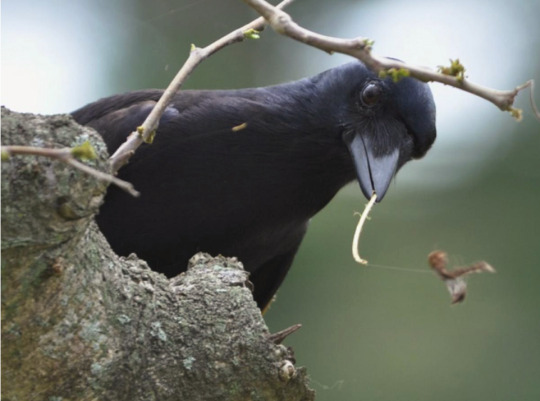
View On WordPress
0 notes
Note
So the markings on Patton are cause of being a poison dart frog, What about the Roman and Logan?
Logan is a Corvus moneduloides, which literally translates to a New Caledonian Crow as in his animal trait, yet he doesn’t usually show his animalistic features, only the robotic ones, why?
He obviously wanted to stand out after Patton stepped down from being the Leader of the Dark Sides, A Single Animal Trait just couldn’t do for him, so he decided to experiment with those kinds of things.
Throughtful the whole process, he found a perfect form to take, and it was an Android, It stood out, it was strong enough as it had special abilities and would be a perfect fit for a strong leader as he took his new position seriously.
As for his abilities...
The Caledonian Crow ones:
-He has the ability to construct and invent various tools and liquified substances without having the ability to create things out of thin air, which only Creativities can do. It is rather difficult and normally requires the skill for the side to do just that, but since his ‘genes’ or however those would be called in the side version, halfly resemble the said bird, it is natural for him to know such things.
-He can also create traps and decoys if he wants to strike someone or if he feels endangered, he does that mainly to Roman out of spite.
-You can’t hide from this guy, he has the sense of the Crow, and even if you hide in a closet, if there is just one tiny hole in the structure, you are simply screwed. Again, mostly used on Roman.
His other abilities are barely noticeable and hard to spot out, but that is mainly how he takes advantage of his animalistic abilities, now let’\s get to the robotic ones:
-He can form out of thin air giant hands created simply from mathematic algorithms and binary codes, he can use those to grab things, which he either can not lift with his own strength, to make things easier or to catch something or someone who gets on his nerves. (Again, very difficult to guess who I’m talking about)
-he can stop the time-being in the mind-scape, so it seems as if he can teleport through it, yet as to not be overpowered his limit is only 5 seconds, while it is limited, he still can do very much in such a short time.
-Can manifest his powers so he can move through the time glitches
-Can fill people’s brains with info-dumping, therefore making their head hurt in a migraine unless they are actually interested in the information during the process, I suppose. (Remus is one of the Immune ones)
As for Roman...
Some of you might’ve noticed the burnt-like markings on his face on the Blog Background Picture, and those markings are actually the venom buds containing the neurotoxin otherwise called homobatrachotoxin.
It is because of his animal trait being Pitohui dichrous otherwise in English Hooded Pitohui, one of the few in the world toxic birds.
Besides his face, the venom buds cover at least 1/2 of his body as well, which simply means that if you would want to touch this guy with bare skin (same goes to Patton unfortunately) you would get serious toxins in your body which would result in serious harm at least and possibly even death at worst, as his skin works exactly like the feathers of the said Hooded Pitohui
Besides the Hooded Pitohui, it is noticed that he has a few more animal traits than simply just that that is due to him also being partly experimented on with his animalistic traits.
And yes, Logan did chose him again for the experiments with the toxin and others, Roman hated every moment of it.
I will not explain every characteristic of Roman’s traits but I can by Percentage add some other animal traits that got included in the process.
-Rattlesnake - 8%
-Fire-breed Dragon - 5%
-Squid - 7%
-Koyote - 5%
-Bat - 8%
-Hooded Pitohui [Main Trait] - 67%
All the Experiments turned out positive but Roman hated Logan’s guts after that.
I know you didn’t need that kind of information, but I just wanted to clear some things out for the future already.
115 notes
·
View notes
Photo
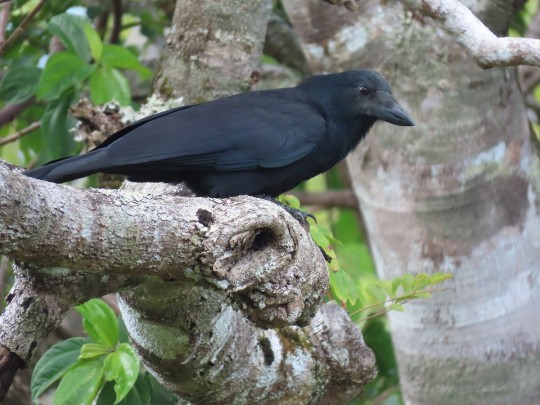
New Caledonian Crow (Corvus moneduloides)
© Jörg Hanoldt
54 notes
·
View notes
Photo
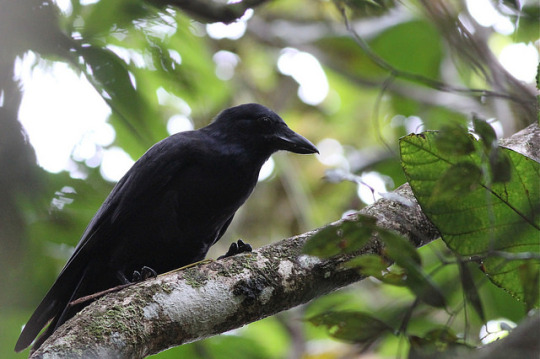
Photo: Chris Wiley - flickr
New Caledonian Crow
Corvus moneduloides
The New Caledonian Crow is native to the French overseas territory of New Caledonia in the South Pacific ocean. The all-black, moderately-sized birds have chisel-shaped beaks some scientists believe evolved their unique shape due to the need to hold twigs steady and straight… twigs used as tools. Several studies have shown convincing evidence of not only tool use by New Caledonian Crows but META-tool use: employing one tool to access another, which is then used to retrieve food. It’s estimated the intelligence of New Caledonian Crows rivals that of higher primates.

Photo: ovenbird1 - flickrf
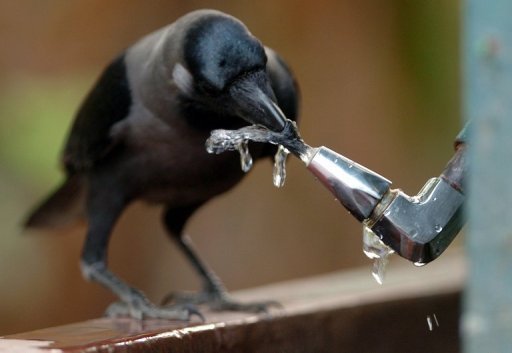
Photo: Physorg.com
0 notes
Text
Lori Gruen: Debunking Human Exceptionalism
Lori Gruen: Debunking Human Exceptionalism
In “Why animals matter”, Lori Gruen debunks the human exceptionalist claim that only humans are worthy of moral concerns because of their superior uniqueness. She breaks the claim down into two implications: Humans have a unique thing X that no other beings possess, and because humans have X, they are above all those who don’t have X.
[1]
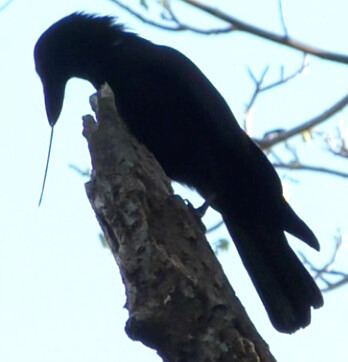
On the first implication, Gruen goes through a number of things commonly considered unique to humans and debunks their exclusivity. This includes tool usage, language usage, theory of mind, and moral engagement. The ability to use tools isn’t exclusive to humans as animals like crows know how to use sticks and bend wires to help retrieve food. Some animals like chimps could learn sign language. Theory of mind was also seen in chimps that recognized food competition as they would not approach the food of dominant chimps showing that they thought about what others could see and not see. Gruen defines morality as caring for others to show that animals care for each other all the time, whether it’s lab rats refusing to electrocute another for food or a large dog restraining themselves to play gently with a small dog. Gruen notices how exceptionalists would often move the goal post each time new evidence proves animals were smarter than previously thought. She quotes Darwin on the differences between humans and non-human animals as “of degree and not of kind”. While humans have more elaborate forms of cognitive skills, nonetheless intelligence as seen in animals proves that it’s not exclusive to humans.
On the second implication, Gruen asks why do differences between humans and animals matter in who gets moral concern. Humans differ in math skill, height, hair color, language, etc., yet none of those differences matter in treating all humans with equal moral concern. She uses language as an example of the X that exceptionalist claims make humans exclusively worthy of moral concern. If language makes humans worthy of moral concern, then what about humans who can’t use language? The exceptionalist’s logic would imply that non-linguistic humans do no matter, they can be killed and it wouldn’t be wrong. Besides the terrible implications, language also isn’t a moral concern considered when we rescue someone in danger, no firefighter risks their lives saving people asking if they are linguistic human beings. Also, language isn’t the only way to express discomfort, babies, mentally deficient people, and animals can all express emotion without language. Exceptionalism cannot provide any universal X that justifies moral concern that is applicable to all humans. If animals have many similar X to humans, exceptionalists can only exclude out of prejudice, without any other defensible positions.

I think Gruen provides a solid case against human exceptionalism. I think an example of X that only humans have which non-humans don’t would be our advanced civilization. An exceptionalist could move the goalpost to argue that while humans may not possess a unique kind of X, our degree of X is so vastly beyond the reach of non-humans, that it is what makes us unique. Building human civilization seems quite impossible for non-humans whether because they lack high degrees of intelligence, social cohesion, or ability to use tools (hands). Because only humans are capable of high-tech civilizations, we are superior to those without it. Gruen’s debunking of the second implication comes as a handy counter to this example. The example defines X in terms of membership with a kind of group, humans are unique members of the only species that have built high-tech civilizations. Gruen would ask if this X actually matters when it comes to deciding moral worth. What about humans who were never part of an advanced civilization? Today, there are plenty of isolated groups of humans, many of which still lived like life before major cities and civilizations. If being a member of an advanced civilization was a requirement for moral concern, then it has terrible implications for how isolated people are treated. The exceptionalist’s logic that justifies superiority over those without X can be seen historically through this example. Past European empires enslaved and killed the native people of lands they colonized. Natives were stereotyped as being primitive and savages compared to the civilized white man. They didn’t have membership in X; therefore, they could be treated as bad as an uncivilized animal.
The exceptionalist logic is similar to the logic of domination that Karen J. Warren mentions as the enemy of all oppressed. Like how the oppression of women is justified by arbitrarily conceived distinctions between men and women like their identification with the mental and physical realms, the exceptionalist claim to superiority over animals is justified by arbitrary degrees of differences with humans. It’s interesting how comparing Warren’s ecofeminism and Gruen’s case against exceptionalism reveals a common goal against the logic of domination.
Question:
Gruen notices how exceptionalists often move the goalpost whenever their claim to human unique is proven untenable. Does this happen in other forms of oppression that use a similar logic of domination?
Word Count: 804
[1] Corvus moneduloides, “New Caledonian Crow Tool-Use,” Flickr (Yahoo!, July 14, 2017), https://www.flickr.com/photos/corvus_moneduloides/35746602572.
0 notes
Text
Corvid Tournament Corvus Bracket Round 1.2: New Caledonian Crow vs Torresian Crow (new pictures!)
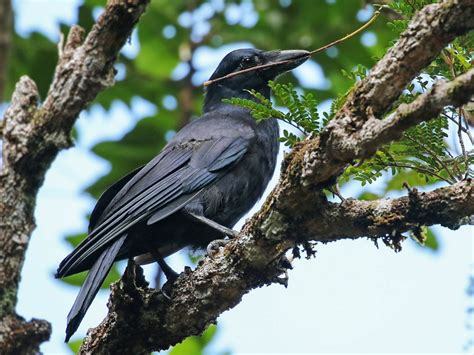
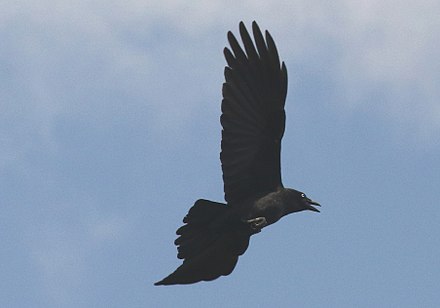
Since they tied last time, here they are again:
New Caledonian crow (corvus moneduloides): Sometimes called a “qua-qua” due to its distinctive sound, this bird is an all-black crow with feathers that sometimes shine green in certain lighting. It is roughly 40cm/16in long, and has a distinct beak as the tip of its lower beak angles up. It resides only on the islands of Grande Terre and Maré Island in New Caledonia. This crow is truly omnivorous and has been heavily documented on its tool use. They have even been observed to use meta- and compound tools, but they do not pass the mirror test. Its conservation status is “least concern."
Torresian crow (corvus orru): Also called the Australian or Papuan crow, it has one of the widest ranges of the Australian species, inhabiting the North and West regions of Australia, Papa New Guinea, and some Indonesian islands. It is a larger bird at roughly 48-53cm/19-21in long, and has a somewhat robust beak. It has black plumage, but its beak and legs are dark-grey, and it has pink foot soles. Torresian crows are true omnivores, and their conservation status is “least concern."
0 notes